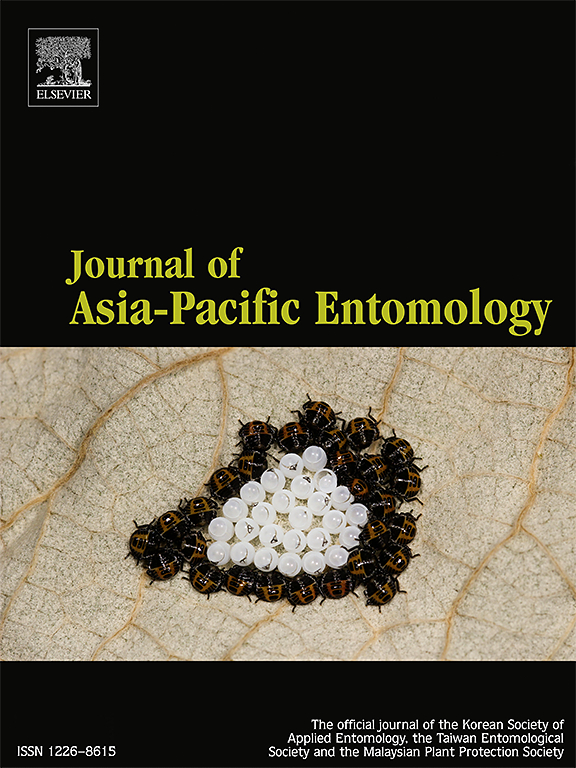Lethal and sublethal effects of azadirachtin on Riptortus pedestris (F.) and its egg parasitoids, Gryon japonicum (Ashmead) and Ooencyrtus nezarae Ishii
IF 1.3
3区 农林科学
Q3 ENTOMOLOGY
引用次数: 0
Abstract
Azadirachtin may cause acute toxicity and alter behavior of natural enemies. We evaluate the lethal and sublethal effect of five concentrations of azadirachtin through topical application and residual exposure on Riptortus pedestris (F.). Its effects were also assessed against egg parasitoids, Gryon japonicum (Ashmead) and Ooencyrtus nezarae Ishii, by pre- and post-parasitization treatment of host eggs. The toxicity of azadirachtin to R. pedestris increased significantly with higher concentrations. A morphological deformity in nymphs was also observed in topical application after molting into the next instar. Azadirachtin significantly reduced egg parasitism by G. japonicum and O. nezarae at concentrations of 15 and 10 mL/L. Interestingly, the male ratio of G. japonicum progeny was increased significantly when host eggs were treated with azadirachtin before parasitization. However, the risk levels of azadirachtin to G. japonicum and O. nezarae were classified as harmless and slightly harmful, respectively, at a concentration of 10 mL/L. Thus, this concentration could be a potential alternative to broad-spectrum chemical insecticides for managing R. pedestris.

印楝素对步行鸟及其卵寄生物日本鹰头虫和麻纹卵通虫的致死和亚致死作用
印楝素可引起急性毒性并改变天敌的行为。我们评估了五种浓度的印楝素的致死和亚致死效应,通过局部应用和残留暴露在Riptortus行人(F.)。通过对寄主卵的寄生前处理和寄生后处理,评价了其对卵类寄生蜂日本Gryon japonicum (Ashmead)和nezarae Ishii的效果。印楝素对小檗的毒性随浓度的增加而显著增加。在若虫蜕皮进入下一龄后,局部应用也观察到形态畸形。印楝素在浓度为15和10 mL/L时显著降低了日本姬虫和尼泊尔姬虫的卵寄生率。有趣的是,寄主卵在被寄生前用印楝素处理后,日本家蝇子代的雄性比例显著提高。而印楝素在浓度为10 mL/L时,对日本姬鼠无害,对nezarae轻微有害。因此,该浓度可能是一种潜在的广谱化学杀虫剂的替代品。
本文章由计算机程序翻译,如有差异,请以英文原文为准。
求助全文
约1分钟内获得全文
求助全文
来源期刊

Journal of Asia-pacific Entomology
Agricultural and Biological Sciences-Insect Science
CiteScore
2.70
自引率
6.70%
发文量
152
审稿时长
69 days
期刊介绍:
The journal publishes original research papers, review articles and short communications in the basic and applied area concerning insects, mites or other arthropods and nematodes of economic importance in agriculture, forestry, industry, human and animal health, and natural resource and environment management, and is the official journal of the Korean Society of Applied Entomology and the Taiwan Entomological Society.
 求助内容:
求助内容: 应助结果提醒方式:
应助结果提醒方式:


